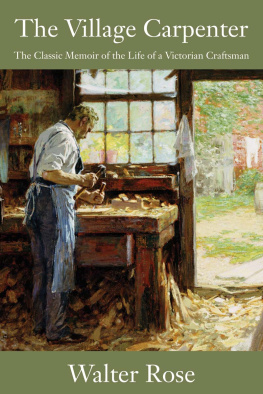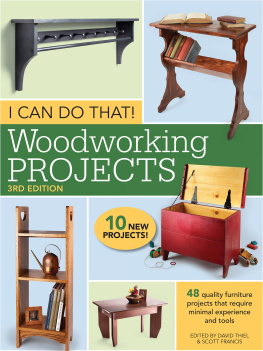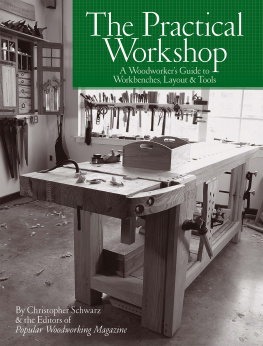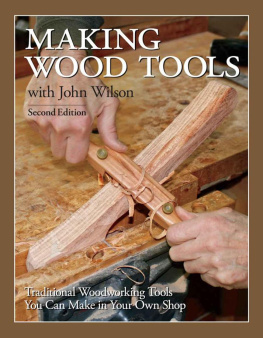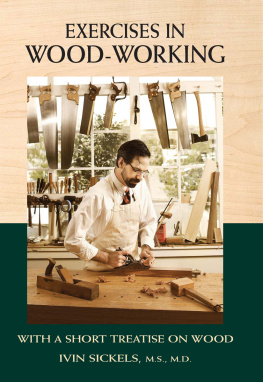

The Village Carpenter
by
Walter Rose
All rights reserved. No part of this book may be reproduced or transmitted in any form or by any means, electronic or mechanical, including photocopying, recording, or by an information storage and retrieval system, without written permission from the publisher.
Originally published in 1937 by Cambridge University Press
Cover art: The Village Carpenter by Edward Potthast
Used with permission
In memory of S. Linden Bookseller
33 Craven St, Strand, London
ISBN: 978-1-61035-051-8
Printed in USA
135798642
Linden Publishing titles may be purchased in quantity at special discounts for educational, business, or promotional use. To inquire about discount pricing, please refer to the contact information below.
Library of Congress Cataloging-in-Publication Data is on file.
Linden Publishing, Inc.
2006 S. Mary
Fresno, CA 93721
www.lindenpub.com
To
ALL LOVERS OF WOODCRAFT
THIS LITTLE WORK IS
DEDICATED
CONTENTS
ILLUSTRATIONS
PHOTOGRAPHS
All photographs except that facing were taken with a Leica camera by M. WIEDLING.
FIGURES IN THE TEXT
INTRODUCTION
There is for half the world a deep-rooted association of domestic modesty, frugality, and wholesomeness about a carpenters shop. We may smile to ourselves to observe the innocence which made a medieval painter portray the holy land as very like his own; but do not we also construct a private image of the home of Joseph and Mary out of free memories of our own homes and what we remember of some village carpenters shop? And so, by an inverse association, the carpenters shop has come by its familiar gentle repute: carpentry seems quite at home in the best known domestic story in the world, and it cannot help gathering a little saintliness by it: we are more christian than we admit.
Not that carpentry itself has nothing to contribute. It would have been harder to domesticate bellows and forge and anvil, had Christ been born a blacksmith. But he was not, and so, whether by chance or a natural orientation of spirit, what was fact was also fitting, a natural-born allegory.
For who has not some pleasant memory of a carpenter: his clean-smelling work, the musical sounds of his tools, his slow, kind, but masterly hands? As Mr Walter Rose points out in this intimate book, carpentry has a very near connection with home life; cupboard and shelf, wainscot and window, table and footstool, are all either creation or patients (or both) of the village carpenter.
When the sweep came, or the plumber, or painter we kept out of the waythey made the house unhomely and we took our things out of the reach of their grime. But a child can watch a carpenter at work without risk of soiling; sawdust is cleaner than snow and not unlike it, and the long curling crinkled shavings, that come off sweetly (as clean as a whistle) are lovelier than any manufactured fabric. Wood is tender stuff, too; you must not bang it about as you must bang iron about, and, handling it gently, carpenters as a race are gentle. They seldom shout; they never leave their tools about.
Mr Roses book, as it goes on, shows a great deal of the carpenters social character. When he says that a man would look at the ends of the chisel handles (the part you hit) to see what sort of a workman owned them, he is giving not a custom of the trade so much as an insight into a carpenters character. The difference between you and me is that I happen to be the one who will have to use this tool, was my remark (he writes) to a salesman who extolled the merits of the saws on the counter to avoid taking the one that I wanted from the window. The saw, eventually purchased, was of marvellous quality, a delight to use. But I took it to work on a new house, it was borrowed by the labourers for cutting firewood, and on my return I found it in my basket broken in two. This simple story is quoted from Mr Roses chapter on tools (). If it was the only speech at the only entrance of an actor in a play, it would (it seems to me) convey the whole character of a carpenter. The tragedy, oddly enough, seems to happen not to Mr Rose, but to the saw. That the saw is broken is the accepted source of emotion; a regretful grief, and not a righteous anger, is the theme. It may be objected that to make much of so slight and casual a quotation is ridiculous. But only think of the difference had this story been told, of one of his tools, by a morose plumber or an irascible blacksmith. The world would have heard something, then, of the character and antecedents of the labourers! In words, too, not so mild as old Enochs notable Blam-me.
Carpenters are not the only craftsmenit may be true of a motor mechanic that the last wipe-over with a greasy rag is half a caress for a job done to an inward satisfactionbut if anyone wants a type of what is best in all craftsmen, ten to one he will choose a carpenter. Have you seen him run his plane first along the edge of the plank, then tilt the plank to test its straightness with the eye, and then (for no purpose but unexpressive affection, that I can see) run the soft pad of his hand down its length, approving its smooth warmth? This is not done to verify that it will function, it is an excess of mild pleasure, it is done because the senses are delighted with wood well worked.
No gaslight ever lit his shop;
He had no wheels to start and stop;
No hot, metallic engines there
Disturbed the shaving-scented air;
His hands were engines, and his eye
His gauge to measure beauty by
How gently time went by for him
Up in that workshop! which grew dim
At sunset time: and then hed lay
His chisels down, and sweep away
The chips and shavings of the day;
But left upon the bench no less
Than that days gain in comeliness;
Then shut the door, and slowly went
Under the rose to bed, content.
A tool working well rings a song to a carpenter, and one ill-sharped or badly set, jibbing at its work and forcing the delicate fibres, gives him pain as discord hurts a musician.
Psychologists say that of all occupations carpentry is the most perfectly balanced between the aesthetic, mental, and physical faculties. How this applies to-day when much of the work that was once done laboriously by hand is done to standard by machines, I do not know; but even the machine-minders in a woodworking shop show susceptibilities about the products of their work that metal-workers seem to lack, and one believes there may be some truth in the virtue of material. Ruskin gave general advice to employ as little fire as possible, and to give preference to methods which do not need to employ it. Wood is alive (Mr Rose is keenly aware of this), and iron is dead; a carpenter who takes no notice of the run of the grain or of the individual qualities of a piece of wood is only a botcher, and I suspect that something of the prejudice against plywood which many older carpenters express, is due to the way that plywood can be treatedwholesale, so much stuff to fill openings with. It baulks carpenters of half their accumulated experience, like a woman who behaves in an unexpectedly mannish manner.
But Mr Rose says nothing of plywood. His memories go back to a time when even veneers were cut at the saw-pit from the log; cut, too, for a job in hand, and cherished accordingly. Yet he is no idoliser of the past for its lostness. He says plainly that he is glad that saw-pits have been replaced by machines, and still he has plenty of hope in his last chapter that carpentry in some degree will continue to exist as a craft. The reader must go there for his reasons and his argument. They are sound; but here is one which he does not, I think, explicitly mention anywhere. It is said that baskets can never be made by machinery. The stitch of baskets found buried with Egyptian mummies is the very same as one of the common stitches in use to-day. The impossibility of machinery is not, however, due to the basket-makers excellent skill, but to the fact that the withies they work in are live stuff that cannot be standardised; and machines, of course, in their ultimate development, can only handle standardised stuff. The same, in its degree, is true of the material that carpenters work in. Mr Rose, it is to be noticed, begins with wood and the untellable secret of its various characters. He can never forget for long that his chisels are turning trees into things, and he knows that the carpenter, at least by proxy of the woodcutter, has roots in the soil. This sense of being part of the life which is part of the land is constantly with him and is one secret, for example, of the charm of the too brief chapters on mills and farm carpentry.
Next page
